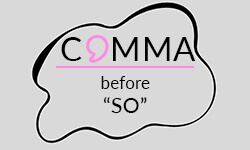
Understanding the use of commas is essential for clear, cohesive, and effective writing in the English language and academic writing. One common area of confusion is the use of a comma before the word “so.” In this article, we will delve into the general comma rules and provide a more profound insight into the issue of when it is appropriate to use a comma before “so”.
When to place a comma before “so”
Placing a comma before “so” depends on what function “so” takes on in the sentence or context. When it functions as a coordinating conjunction to connect two independent clauses, it should be preceded by a comma. However, if the word “so” functions as an adverb or subordinating conjunction, meaning “in order that” or “to such an extent,” and introduces a dependent clause, a comma should not be placed.
Comma
Coordinating conjunction
Linking independent clauses
No comma
Subordinating conjunction
Introduces a dependent clause
The primary rule is to proceed with placing a comma before “so” when “so” acts as a coordinating conjunction linking two independent clauses. However, there may be exceptions to this rule. In some cases, closely related and short independent clauses may be more flowy if the comma is omitted, despite “so” functioning as a coordinating conjunction. Remember, these kinds of exceptions do not invalidate the primary rule, but rather provide flexibility in certain contexts.
Comma before “so”
When the word “so” acts as a coordinating conjunction and connects two independent clauses, a comma must be placed before “so”.
Coordinating conjunction
When two independent clauses are connected with “so”, it functions as a coordinating conjunction, which means a comma should be placed before it, as shown in the following examples:
All example sentences represent two independent clauses being linked by the coordinating conjunction “so”, where a comma must be placed.
Linking independent clauses
An independent clause refers to a section of a sentence that can stand on its own because it contains a subject and a verb. By using “so” as a coordinating conjunction, two independent clauses can be linked together.
No comma before “so”
In general, there is no placement of a comma before “so”, when a dependent clause is introduced, and “so” functions as a subordinate conjunction.
Subordinating conjunction introducing dependent clause
A comma should not be placed before “so” when “so” is used as a subordinating conjunction to imply a result or a purpose. This is shown in the examples below:
All sentences introduce the purpose of the action taken in the first part of the sentence with “so”. As it introduces a dependent clause and refers to a subordinating conjunction, a comma is not necessary.
Introducing dependent clauses
When “so” is used to introduce a dependent clause, it typically expresses an incomplete thought and can’t stand by itself as an independent sentence. In these cases, the comma is ommited:
Special case: No comma before “so”
In some cases, the placement of a comma before “so” can be subjective, depending on the writing style or emphasis the author aims to convey. Instances of using no comma before “so” although it acts as a coordinating conjunction linking two independent clauses may occur in informal and creative writing, interruption of flow, or drawing emphasis on something specific.
Test yourself!
Practice sheet
To test your comprehension of using commas before “so”, try placing them in the spaces in the 10 sentences. Afterward, check the answer tab to verify if you have understood the comma usage before the word “so”.
- She was starved so she ordered a family pizza.
- I didn’t want to wake the baby up so I whispered to my friend.
- It’s a rainy day so we shouldn’t go to the park.
- The snow was not stopping so we decided to stay inside.
- They studied hard so they could pass the test.
- We run everyday so that we can stay in shape.
- The film was completely booked so they chose another one.
- I didn’t want to be late so I left an hour in before.
- It was his birthday so I bought him a last minute gift.
- He practiced the guitar so he would improve.
- She was starved, so she ordered a family pizza. (Comma)
- I didn’t want to wake the baby up so I whispered to my friend. (No comma)
- It’s a rainy day, so we shouldn’t go to the park. (Comma)
- The snow was not stopping, so we decided to stay inside. (Comma)
- They studied hard so they could pass the test. (No comma)
- We run everyday so that we can stay in shape. (No comma)
- The film was completely booked, so they chose another one. (Comma)
- I didn’t want to be late so I left an hour in before. (No comma)
- It was his birthday, so I bought him a last minute gift. (Comma)
- He practiced the guitar so he would improve. (No comma)
- ✓ 3D live preview of your individual configuration
- ✓ Free express delivery for every single purchase
- ✓ Top-notch bindings with customised embossing

FAQs
The general rule is that there is no comma after “so”, regardless of it being a coordinating or subordinating conjunction. In some cases, a comma is placed after “so” when it stands in the first place of the sentence.
A comma before “so” is only necessary when “so” acts as a coordinating conjunction connecting two independent clauses. In rare cases, a comma is placed after “so” when it acts as a parenthetical element or stands at the beginning of a sentence.
When “so” introduces a dependent clause and functions as a subordinating conjunction, the comma is omitted.